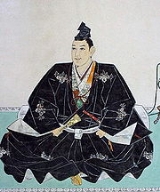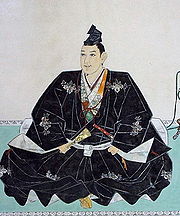
Ukita Hideie
Encyclopedia

was the daimyo
Daimyo
is a generic term referring to the powerful territorial lords in pre-modern Japan who ruled most of the country from their vast, hereditary land holdings...
of Bizen
Bizen Province
was a province of Japan on the Inland Sea side of Honshū, in what is today the southeastern part of Okayama Prefecture. It was sometimes called , with Bitchu and Bingo Provinces. Bizen borders Mimasaka, Harima, and Bitchū Provinces....
and Mimasaka
Mimasaka Province
or was a province of Japan in the part of Honshū that is today northeastern Okayama Prefecture. Mimasaka bordered Bitchū, Bizen, Harima, Hōki, and Inaba Provinces....
provinces (modern Okayama Prefecture
Okayama Prefecture
is a prefecture of Japan located in the Chūgoku region on Honshū island. The capital is the city of Okayama.- History :During the Meiji Restoration, the area of Okayama Prefecture was known as Bitchū Province, Bizen Province and Mimasaka Province.- Geography :...
), and one of the council of Five Elders
Council of Five Elders
The council of five elders, also known as the five Tairō , was formed by Toyotomi Hideyoshi to rule Japan in the place of his son, Hideyori, until such time as he came of age. Hideyoshi chose his five most powerful daimyo: Ukita Hideie, Maeda Toshiie, Uesugi Kagekatsu, Mōri Terumoto, and the...
appointed by Toyotomi Hideyoshi
Toyotomi Hideyoshi
was a daimyo warrior, general and politician of the Sengoku period. He unified the political factions of Japan. He succeeded his former liege lord, Oda Nobunaga, and brought an end to the Sengoku period. The period of his rule is often called the Momoyama period, named after Hideyoshi's castle...
. Son of Ukita Naoie
Ukita Naoie
was a Japanese daimyo of the Sengoku period. He was born in Bizen Province, to Ukita Okiie, a local samurai leader. After the assassination of Naoie's grandfather Yoshiie in 1534, he was left homeless along with his father, but both were soon taken in by Murakami Munekage, the lord of Tenjinzan...
, he married Gohime, a daughter of Maeda Toshiie
Maeda Toshiie
was one of the leading generals of Oda Nobunaga following the Sengoku period of the 16th century extending to the Azuchi-Momoyama period. His father was Maeda Toshimasa. He was the fourth of seven brothers. His childhood name was "Inuchiyo" . His preferred weapon was a yari and he was known as...
. Having fought against Tokugawa Ieyasu
Tokugawa Ieyasu
was the founder and first shogun of the Tokugawa shogunate of Japan , which ruled from the Battle of Sekigahara in 1600 until the Meiji Restoration in 1868. Ieyasu seized power in 1600, received appointment as shogun in 1603, abdicated from office in 1605, but...
in the Battle of Sekigahara
Battle of Sekigahara
The , popularly known as the , was a decisive battle on October 21, 1600 which cleared the path to the Shogunate for Tokugawa Ieyasu...
he was exiled to the island prison of Hachijōjima
Hachijojima
is a volcanic Japanese island in the Philippine Sea, administered by Tōkyō and located approximately south of the Special Wards of Tōkyō. It is the southernmost and most isolated of the Izu Seven Islands group of the seven northern islands of the Izu archipelago...
, where he died.
Rise to prominence
Hideie's father Naoie was daimyo of Bizen province and initially opposed, but later sided with Oda NobunagaOda Nobunaga
was the initiator of the unification of Japan under the shogunate in the late 16th century, which ruled Japan until the Meiji Restoration in 1868. He was also a major daimyo during the Sengoku period of Japanese history. His opus was continued, completed and finalized by his successors Toyotomi...
and Toyotomi Hideyoshi
Toyotomi Hideyoshi
was a daimyo warrior, general and politician of the Sengoku period. He unified the political factions of Japan. He succeeded his former liege lord, Oda Nobunaga, and brought an end to the Sengoku period. The period of his rule is often called the Momoyama period, named after Hideyoshi's castle...
. Naoie died in 1581, and in 1582 Hideie became the head of the Ukita clan. As Hideie was still young, it was Hideie's uncle [Tadaie] who acted as leader of the Ukita army (under Toyotomi Hideyoshi) during the siege of Bitchu Takamatsu Castle
Takamatsu Castle (Bitchu)
Takamatsu Castle of Bitchu Province was a Japanese castle located in what is today the city of Okayama in Okayama Prefecture. Like most Japanese castles, it was built in the late 16th century, during the Azuchi-Momoyama period of Japanese history.The castle, of the hirajō type, was built very...
in 1582. Nobunaga was assassinated on June 2 of that year, but the siege continued until the castle fell two days later. Hideyoshi raced back to Kyoto, leaving the Ukita clan in charge of Bizen, Mimasaka and newly taken parts of Bitchu provinces. The Ukita were also to keep watch on Mōri Terumoto
Mori Terumoto
Mōri Terumoto , son of Mōri Takamoto and grandson and successor of the great warlord Mōri Motonari, fought against Toyotomi Hideyoshi but was eventually overcome, participated in the Kyūshū campaign on Hideyoshi's side and built Hiroshima Castle, thus essentially founding Hiroshima.Terumoto was a...
to the west.
In 1586, Hideie was married to Hideyoshi's adopted daughter, Gohime. (She had been adopted by Hideyoshi from Maeda Toshiie.)
Hideie joined Hideyoshi's military campaigns in Shikoku (1585), Kyushu (1586) and the Siege of Odawara
Siege of Odawara (1590)
The third ' occurred in 1590, and was the primary action in Toyotomi Hideyoshi's campaign to eliminate the Hōjō clan as a threat to his power. The months leading up to it saw hasty but major improvements in the defense of the castle, as Hideyoshi's intentions became clear...
(1590). Following the unification of Japan under Hideyoshi, Hideie joined the Korean campaigns, returning in 1598 to serve as one of Hideyoshi's five counselors, along with Maeda Toshiie
Maeda Toshiie
was one of the leading generals of Oda Nobunaga following the Sengoku period of the 16th century extending to the Azuchi-Momoyama period. His father was Maeda Toshimasa. He was the fourth of seven brothers. His childhood name was "Inuchiyo" . His preferred weapon was a yari and he was known as...
, Uesugi Kagekatsu
Uesugi Kagekatsu
was a daimyo during the Sengoku and Edo periods of Japanese history. The son of Nagao Masakage and husband of Uesugi Kenshin's elder sister, Aya-Gozen. After his father died, he was adopted by Kenshin....
, Mōri Terumoto
Mori Terumoto
Mōri Terumoto , son of Mōri Takamoto and grandson and successor of the great warlord Mōri Motonari, fought against Toyotomi Hideyoshi but was eventually overcome, participated in the Kyūshū campaign on Hideyoshi's side and built Hiroshima Castle, thus essentially founding Hiroshima.Terumoto was a...
, and Tokugawa Ieyasu
Tokugawa Ieyasu
was the founder and first shogun of the Tokugawa shogunate of Japan , which ruled from the Battle of Sekigahara in 1600 until the Meiji Restoration in 1868. Ieyasu seized power in 1600, received appointment as shogun in 1603, abdicated from office in 1605, but...
.
Battle of Sekigahara
Hideyoshi died in 1598, leaving his five-year-old son HideyoriToyotomi Hideyori
was the son and designated successor of Toyotomi Hideyoshi, the general who first united all of Japan. His mother, Yodo-dono, was the niece of Oda Nobunaga....
as his successor and Tokugawa Ieyasu moved to take control. Hideie contributed 17,000 men to the Toyotomi army at the Battle of Sekigahara
Battle of Sekigahara
The , popularly known as the , was a decisive battle on October 21, 1600 which cleared the path to the Shogunate for Tokugawa Ieyasu...
but they were defeated after many of their "allies" defected to the Tokugawa side. One of these defectors was Kobayakawa Hideaki
Kobayakawa Hideaki
Kobayakawa Hideaki was fifth son of Kinoshita Iesada and the nephew of Toyotomi Hideyoshi.He was adopted by Hideyoshi and called himself Hashiba Hidetoshi and Shusen . He was then again adopted by Kobayakawa Takakage and renamed himself Hideaki...
, who was granted Okayama Castle and surrounding Ukita territories as the spoils of war.
Hideie escaped from the confusion of the battlefield, but was later found and exiled to the island of Hachijōjima
Hachijojima
is a volcanic Japanese island in the Philippine Sea, administered by Tōkyō and located approximately south of the Special Wards of Tōkyō. It is the southernmost and most isolated of the Izu Seven Islands group of the seven northern islands of the Izu archipelago...
, along with several supporters, including his two sons and their nurse(s?). Hideie's wife sought refuge with the Maeda clan and was able to correspond and send gifts (rice, sake, clothing) to her husband and sons from there.
Hideie eventually outlived his wife and all of the sengoku (warring states) era samurai. He was offered a conditional pardon after Ieyasu's death, but declined and never returned to the mainland. His wife had died, the Toyotomi were defeated, there was no place to return to, his sons had fathered children on Hachijo, and the Shogunate was to be inherited by members of the Tokugawa clan.
There is no evidence to suggest that Hideie fathered any further children himself, but many of his sons' descendants emigrated back to the Japanese mainland when a full pardon was granted at the end of the Tokugawa era.

